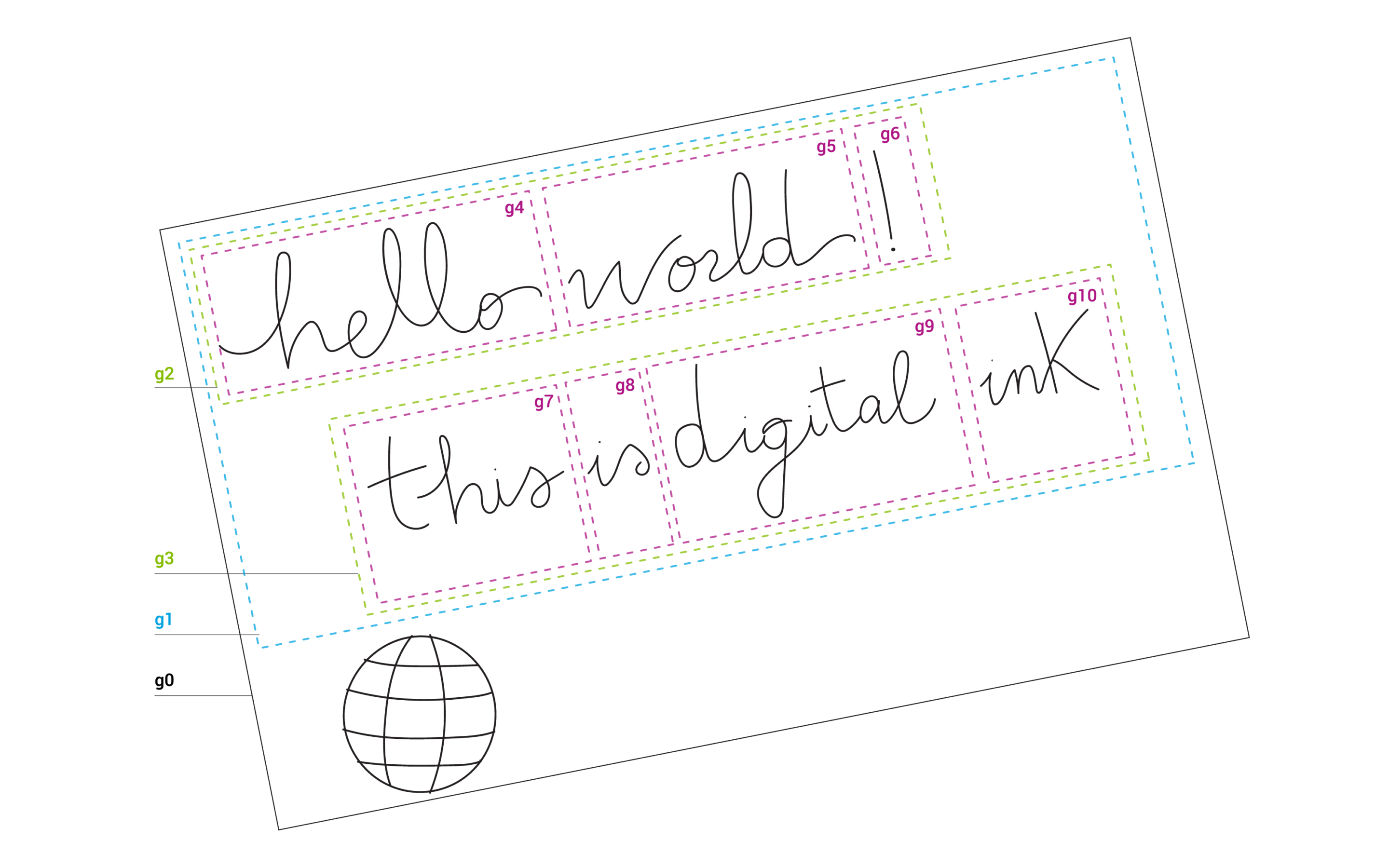What is Semantic Ink?
Every ink stroke has its semantic meaning and Artificial Intelligence (AI) technology can be used to understand its semantics. To do so, Wacom utilizes several AI technologies.
One part of AI is knowledge management. Knowledge management in the context of AI involves the systematic organization, storage, retrieval, and utilization of knowledge to enhance the capabilities of artificial intelligence systems. It plays a critical role in making AI more efficient, effective, and valuable in various applications. The key components of knowledge management in the context of AI are knowledge acquisition, representation, storage, retrieval, and utilization. The Semantic Ink technology is dominant in the acquisition and representation of knowledge. Its purpose is to organize the knowledge and content an organization accumulates.
This article outlines how the Semantic Ink technology recognizes and analyses data to make processes more streamlined and efficient and walks you through the different layers of Wacom’s Semantic Ink technology stack.
Semantics
To understand what Semantic Ink technology is, first we need to discuss semantics. “Semantic” refers to the meaning or interpretation of language elements, including words, phrases, and symbols, by understanding their underlying significance, intent, and relationships.
For example, consider the word “present.” Depending on the context, it could mean either a gift or the current time. Without context, it is impossible to determine which meaning is intended. Semantic understanding provides a framework for defining and identifying meanings in language by considering the context in which words are used. It helps uncover the intended interpretation of words or phrases, enabling more accurate comprehension and communication.

Recognition services
Ink applications use Wacom WILL rendering pipeline to convert stylus sensor data to digital ink. But, to make digital ink digitally processable we need to convert digital ink to machine processable text, representations of math, or diagrams.
For converting ink into machine-processable text and math content, Wacom uses cloud AI services to convert ink strokes in text or math. However, there is a limitation to handwriting recognition technology. It must know the type of content if its text, math, or diagram. Here, the Wacom technology machine learning (ML) team is working on a deep learning technology to automatically separate between text, math stroke, or other strokes. This technology is called Ink Analyzer.

Ink Analyser Technology
Wacom’s Ink Analyzer technology utilizes deep learning to enhance digital ink recognition. It employs advanced neural networks to analyze each stroke in digital ink input, accurately classifying its content type. Trained on extensive datasets, the neural network extracts feature from strokes, enabling precise classification of math, text, and other content types like diagrams or doodles.
The Ink Analyzer scrutinizes each stroke in digital ink, extracting essential features like shape, curvature, and spatial arrangement. These features inform the neural network’s classification of content types for each stroke. With the Ink Analyzer, workflow efficiency is optimized as it autonomously conducts recognition processes without human intervention.
Universal Ink Model
Wacom Universal Ink Model is capable of collecting stylus sensor data, such as position on screen (x, y coordinates on surface), timestamps, pressure, tilt etc. and it can capture the results from intelligent algorithm (such as handwriting recognition, math recognition, or Semantic Analysis of content) directly with the ink.


Private Knowledge Service
The private knowledge service is essential for structuring knowledge and organizing digital ink notes within the knowledge graph. It is based on four core components:

These components enable use:
- to define the terminology of a domain,
- structure its content,
- link the knowledge with digital ink,
- and semantically search for knowledge and content.
The ontology service provides a structured framework for representing knowledge in a specific domain, defining concepts, categories, and their relationships to ensure interoperability and data integration across systems. This standardization facilitates efficient search and discovery by organizing concepts hierarchically. The graph service builds on this by creating knowledge graphs that capture domain-specific information, improving search experiences. Named Entity Linking (NEL) connects text entities to the knowledge graph, enhancing document organization and content representation. Semantic search, leveraging these structured connections, improves query relevance by understanding context and meaning, leading to more accurate search results and richer user interactions. To put it simply, Semantic search is an advanced search method using knowledge graphs and semantic embeddings, which are sophisticated vector representations that capture the meaning of words, phrases and documents. However, it is important that we are organizing private content in the right way through semantics to reach optimal results.
Putting it all together
These technologies collaborate to enhance user search experiences. Here is an overview of the process:
- Users create handwritten or uploaded digital content. Only handwritten text content – thanks to Ink Analyzer technology – undergoes handwriting recognition to convert it into digital text.
- The text is analysed, and key entities are identified and linked to entities in the Knowledge Graph through Named Entity Linking, establishing connections and context.
- Text is segmented into paragraphs and passed through an embedding model, which computes vectors representing the text within a vector space. Documents are stored in a vector database based on similarity, grouping similar content.
- During a user’s search, an initial semantic search identifies relevant terms related to the query, aiding users in discovering related terms to enhance their search.
- The search is conducted for documents, considering both the similarity of search terms to documents and the relationships between the query and documents in the Knowledge Graph. This includes considering whether the search term is a keyword or related entity of the document, improving search accuracy and relevance.
Benefits
Semantic search provides significant improvements over traditional keyword-based search methods by focusing on the meaning and context of search queries rather than just matching exact keywords. Traditional keyword-based search relies on exact matches of keywords in the search query and does not account for synonyms, related terms, or the overall context in which the words are used. In contrast, semantic search uses natural language processing (NLP) and machine learning techniques to understand the context and intent behind a search query. This approach allows it to recognize synonyms, related concepts, and the contextual meaning of words, making the search process more intuitive and effective.
Capturing user intent is a critical aspect where traditional keyword-based search methods often fall short. When users input vague or ambiguous queries, keyword-based systems struggle to discern the underlying intent, leading to irrelevant or incomplete results. For instance, a search query like “best places” might yield a broad array of results that lack coherence or specificity to what the user seeks. In contrast, semantic search excels by interpreting the user’s intent, even when the query is not precise. It leverages advanced natural language processing (NLP) techniques to understand the context and nuances of the search terms, providing results that are more aligned with the user’s expectations.
Utilizing semantic embeddings marks a significant advancement over traditional keyword matching. Keyword-based search systems rely on the exact presence of search terms within documents, often missing relevant information expressed differently. Semantic search employs semantic embeddings. This approach allows the search engine to identify documents with similar meanings, regardless of whether the exact keywords are used. For example, a query for “automobile repair” would also return documents that mention “car maintenance,” ensuring a more comprehensive and relevant set of results.
Semantic search enhances the accuracy and relevance of search results through contextual understanding. By analysing the context in which words appear, semantic search engines can more accurately interpret queries. For example, the term “Apple” will yield technology-related results when associated with words like “iPhone” or “MacBook,” but will refer to the fruit when the context includes terms like “recipe” or “nutrition.” This context-aware approach, combined with the power of semantic embeddings and NLP, ensures that users receive results that are not only more precise but also more relevant to their actual needs. Consequently, semantic search provides a much richer and more effective search experience, addressing the limitations of traditional keyword-based methods.
Use cases
There are many use cases for such technology, including education. For example, Semantic Ink can systematize educational content such as learning materials, worksheets, lecture notes, and handouts to link it with your handwriting. This technology can help educators organize and retrieve educational resources efficiently, enabling more personalized and effective teaching methods. Students can also benefit from improved access to relevant study materials, fostering a more interactive and engaging learning experience.
However, the potential applications of Semantic Ink extend much beyond education. The creative industry, including game studios and movie productions, can also greatly benefit from this technology. The Private Knowledge System can facilitate the organization of various digital assets like textures, 3D models, audio assets, visual effects (VFX), and more. By organizing these assets in knowledge graphs, they become easily searchable and retrievable, streamlining the production process and enhancing collaboration among team members. For instance, game developers can quickly find the necessary assets for character design, while movie producers can efficiently manage and access the multitude of elements required for post-production. This improved organization not only saves time but also enhances the overall quality of creative projects by ensuring that all necessary resources are readily available.
To put it simply, Semantic Ink technology stack is applicable to industries accumulating content that later needs to be utilized and searched. Be it public or private sector, Semantic Ink technology can be leveraged accordingly.
Conclusion
In summary, Semantic Ink technology offers distinct advantages and business should evaluate their specific requirements for data integration, scalability, semantic capabilities. Semantic Ink technology by Wacom provides flexibility, excels in relationship exploration, and offer robust scalability and integration options within the ecosystem, including advanced semantic capabilities and ontology services.
In need for more information or interested to try out the technology stack solutions, please feel free to contact us. You can also subscribe for Wacom newsletter here, read our articles here or follow us on Twitter and LinkedIn.






